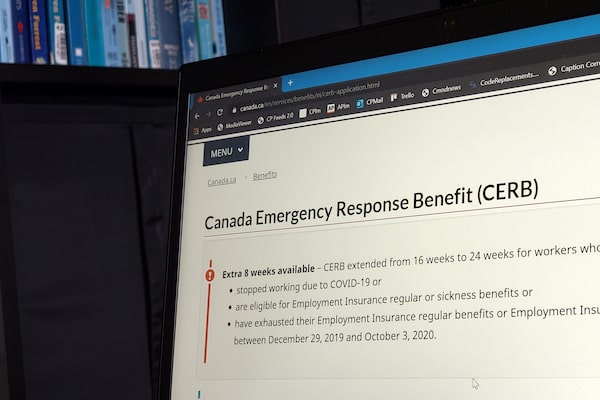
In this file photo, a person walks past a COVID-19 mural in Toronto, on April 12, 2021.Nathan Denette/The Canadian Press
In north Toronto, an employee of a large food manufacturing plant used all three of her paid sick days after testing positive for the Omicron variant of COVID-19. It was the week between Christmas and New Year’s Day and she still had symptoms, so she was contemplating using the last three of her 10 annual paid vacation days to continue staying home.
In the end, she took two more days, then forced herself back to work, fearing she would otherwise be asked to take unpaid leave. She was unaware that she was eligible for the Canada Recovery Sickness Benefit, a $450-a-week federal subsidy for people who are ill or who need to isolate because of COVID-19.
The Globe and Mail is not naming the worker because she was not authorized by her employer to speak to the media.
Economists, business lobby groups and labour advocates are divided over whether it’s feasible for the federal government to continue offering pandemic-relief programs such as the Canada Recovery Sickness Benefit, but there is also debate over a more fundamental question: Are these programs actually helping people deal with the financial consequences of staying home while ill?
Some economists believe benefits programs have been too generous, and that throwing money at a systemic issue such as labour market inequity simply does not work.
More reading
Retail workers face jumble of corporate sick-pay policies amid Omicron surge
Why billions in federal sick-leave benefits have gone untapped
Many labour advocates, meanwhile, argue federal benefits programs, even if they retroactively pay people who can’t work because of illness, are inadequate because the payments are too small and too complicated to access. They say a lack of paid sick days is at the heart of why so many of those who are not able to work from home are struggling to weather the pandemic.
“There continue to be thousands of workers falling through the cracks of the benefits system,” said Jim Stanford, an economist and director of the Centre for Future Work, a Vancouver-based think tank.
The food-processing plant worker was able to take three paid sick days only because that amount of time off is mandated by a temporary provincial sick-leave program, which Ontario extended until July 31 after much pressure from opposition parties, unions and other worker advocacy groups. She, like many other low-wage workers, has no employer-provided paid sick days and often comes into work ill.
“You need to remember that every cent counts for low-wage workers. They cannot afford to miss a paycheque. So for the most part, they will pop a Tylenol and go into work, regardless of COVID,” explained Deena Ladd, executive director of the Workers’ Action Centre, a non-profit agency that helps predominantly low-wage workers navigate workplace issues.
There continue to be thousands of workers falling through the cracks of the benefits system
— Jim Stanford, an economist and director of the Centre for Future Work, a Vancouver-based think tank
A recent survey conducted by the Environics Institute for Survey Research at Ryerson University found almost 40 per cent of Canadians went to work sick at least once during the pandemic. The survey did not include people who were able to work from home.
Most Organization for Economic Co-operation and Development countries, with the exception of Britain and the United States, require employers to provide at least two weeks of paid sick leave. In Canada, paid sick-day policies vary by province. British Columbia requires five permanent paid sick days, Quebec two days and Prince Edward Island one day. The federal government recently passed a bill to implement 10 paid sick days for federally regulated employees, but the new requirement only applies to roughly 10 per cent of the country’s total work force.
According to a report from the Decent Work and Health Network, a non-profit group made up of public-health advocates, about 58 per cent of Canadian workers do not have access to paid sick leave through their employers. Among those making less than $25,000 a year, the proportion is 70 per cent.
Malini Rajan, who worked as a server at two different bars in Toronto until the latest lockdown, said there was a silent understanding among workers that it was unfair to “snitch” on colleagues who came into work sick with COVID-19. “There were just too many of us sick. You can only afford to take time off work if you have worked enough hours, or gotten enough tips that week,” she said.

People are seen inside a restaurant and on an outdoor patio at English Bay, in Vancouver, B.C., on June 21, 2021.DARRYL DYCK/The Canadian Press
The Ontario Federation of Labour, alongside members of Ontario’s New Democratic Party and a slew of other unions and worker groups, has spent years pushing for the province to require employers to provide 10 permanent paid sick days. But various iterations of the Stay Home If You Are Sick Act, introduced by NDP MPP Peggy Sattler, have been voted down in the provincial legislature repeatedly. Bill 8, the latest version of the act, will come up for a vote later this year.
Business lobby groups – which, like Ontario Premier Doug Ford, vehemently oppose an increase in sick time for workers – say the existence of the Canada Recovery Sickness Benefit negates the need for paid sick days.
But uptake of the program has been weak. Since its introduction in the fall of 2020 there have only been about 820,000 applicants. Canada’s initial pandemic subsidy for individuals, the Canada Emergency Recovery Benefit (better known as CERB), had about 8.9 million before it ended.
Ms. Rajan said she had heard of the Canada Recovery Sickness Benefit, but assumed she wouldn’t qualify for it even if she was sick with COVID-19. Labour advocates say this is a common misconception among workers.
The main reasons people who qualify for the Canada Recovery Sickness Benefit do not apply for it is they are not sure if they are eligible, and cannot afford to wait for the benefit money to arrive, according to Ms. Ladd. “It is all about seamless access. When someone is sick, you want them to know immediately that they will get paid for staying at home. And from a public-health perspective, with COVID, you want to instantly stop the person from going into work sick.”

The landing page for the Canada Emergency Response Benefit is seen in Toronto, Monday, Aug. 10, 2020.Giordano Ciampini/The Canadian Press
Ms. Ladd, alongside many other labour advocates, economists and public-health groups, said she believes CERB – which required less paperwork than the Canada Recovery Sickness Benefit, had broad eligibility and gave applicants a pretax amount of $2,000 every four weeks – should have been sustained throughout the pandemic, at least until other public policy tools, such as paid sick days, were uniformly implemented across the country.
But Parisa Mahboubi, an economist with the C.D. Howe Institute in Toronto, said she believes it is impossible to design benefits programs that adequately address the needs of all workers, especially in an ever-changing situation such as the pandemic. “CERB was a popular program because it was broad-based and everyone knew about it. The rules were clear. But it cannot be a permanent solution for governments to offer such a broad program forever,” she said.
The conversation about government pandemic benefits, is, in a way, a revival of an age-old ideological debate among economists: Do benefit programs discourage workers from participating in the labour force, or are they a necessary instrument for creating a more equitable society?
Pedro Antunes, chief economist at the Conference Board of Canada, an Ottawa-based think tank, said in general Canada’s benefits programs over the pandemic have been “extremely” generous. “How easy or difficult it is to apply for those programs, I do not know. But we have seen household incomes grow strongly because of the support programs.” Mr. Antunes said he believes that, to some extent, CERB discouraged workers from rejoining the labour force.
CERB was a popular program because it was broad-based and everyone knew about it. The rules were clear. But it cannot be a permanent solution for governments to offer such a broad program forever
— Parisa Mahboubani, economist with the C.D. Howe Institute in Toronto
(Statistics Canada data show food and beverage sector workers, in particular, did end up leaving their jobs during the period when CERB was available. But they largely rejoined other sectors of the economy – ones that arguably provide better working conditions.)
Mr. Stanford of the Centre for Future Work pointed out employers have a large role to play when it comes to improving working conditions, especially during the pandemic. “There is no reason why the burden of toiling through the pandemic for workers has to rest solely on governments,” he said.
In November, the Canadian Federation for Independent Businesses came out in opposition to the federal government’s paid sick days bill, arguing it would increase costs for businesses at a time when many small companies have been struggling with stop-start lockdown measures.
A November, 2021, report published by the Centre for Future Work, with research led by Mr. Stanford, concluded if employers in B.C. were to offer up to 10 days of paid sick leave, they would incur an increase in business expenses of between 0.15 and 0.3 per cent, on average.
Gilleen Pearce, founder of the Better Way Alliance, a group of business owners advocating for better treatment of workers, said the idea of paid sick time eating into a company’s profits is “misunderstood and misrepresented.”
“There are real, tangible benefits on a micro level of offering better working conditions like higher wages and paid sick days. Hiring is expensive,” she said. “In my experience, an employee who simply has an adequate number of sick days, especially during the pandemic, is going to be incentivized to stay much longer in a job. In terms of productivity, and loyalty to a company, that is better for the bottom line.”
Sign up for the Coronavirus Update newsletter to read the day’s essential coronavirus news, features and explainers written by Globe reporters and editors.